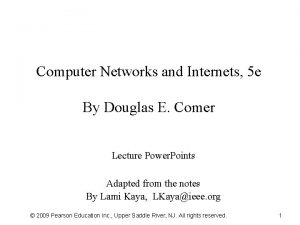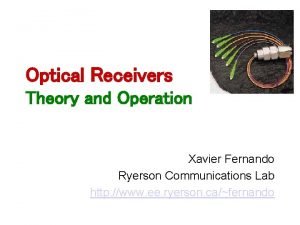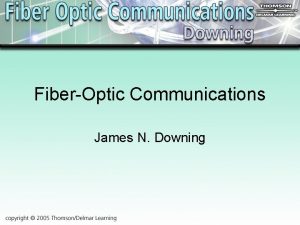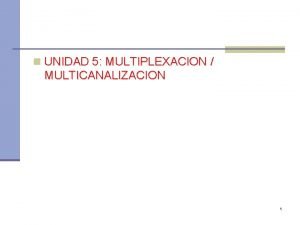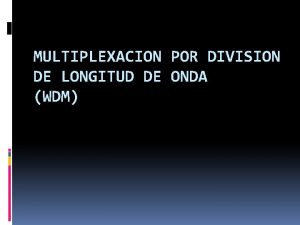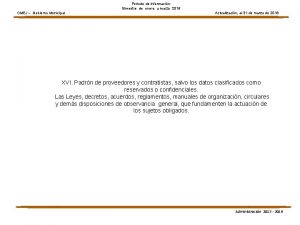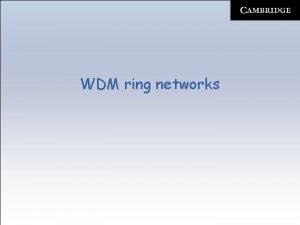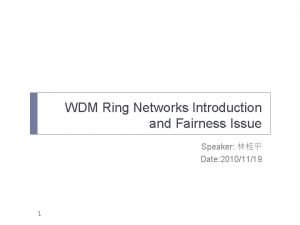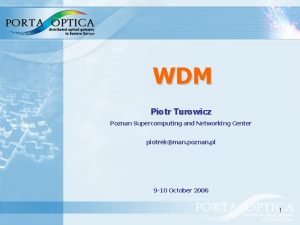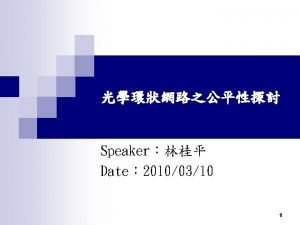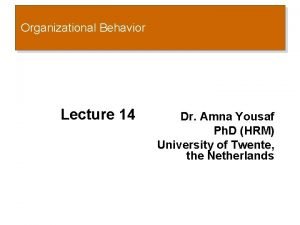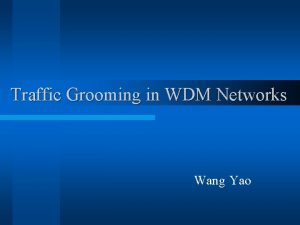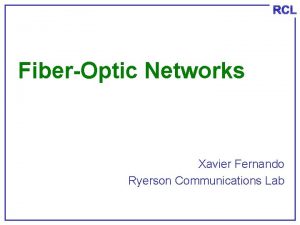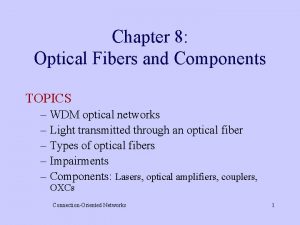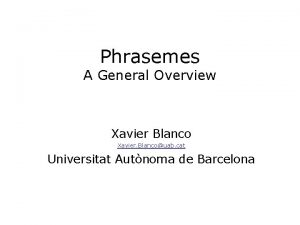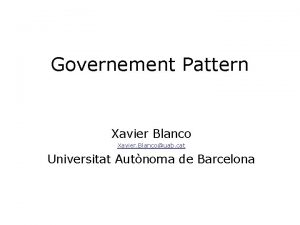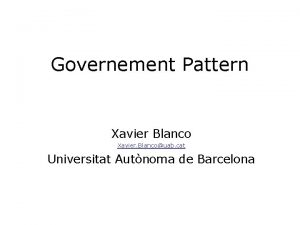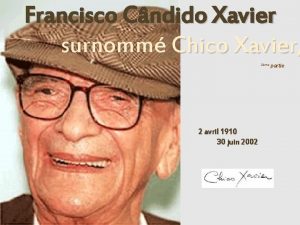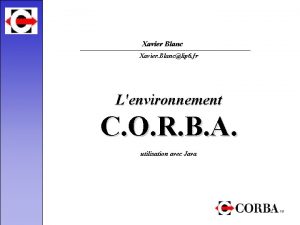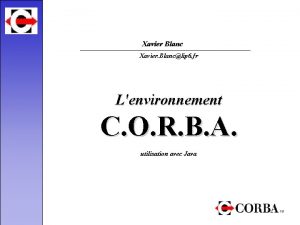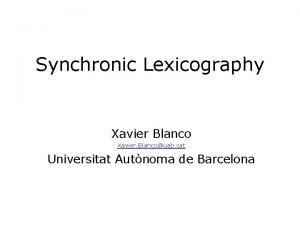Components for WDM Networks Xavier Fernando ADROIT Group













































- Slides: 45

Components for WDM Networks Xavier Fernando ADROIT Group Ryerson University

Passive Devices • These operate completely in the optical domain (no O/E conversion) and does not need electrical power • Split/combine light stream Ex: N X N couplers, power splitters, power taps and star couplers • Technologies: - Fiber based or – Optical waveguides based – Micro (Nano) optics based • Fabricated using optical fiber or waveguide (with special material like In. P, Li. Nb. O 3)

10. 2 Passive Components • Operate completely in optical domain • N x N couplers, power splitters, power taps, star couplers etc.

Fig. 10 -3: Basic Star Coupler May have N inputs and M outputs • Can be wavelength selective/nonselective • Up to N =M = 64, typically N, M < 10

Fig. 10 -4: Fused-fiber coupler / Directional coupler • P 3, P 4 extremely low ( -70 d. B below Po) • Coupling / Splitting Ratio = P 2/(P 1+P 2) • If P 1=P 2 It is called 3 -d. B coupler

Definitions Try Ex. 10. 2

Coupler characteristics : Coupling Coefficient

Coupler Characteristics • By adjusting the draw length of a simple fused fiber coupler, – power ratio can be changed – Can be made wavelength selective

Wavelength Selective Devices These perform their operation on the incoming optical signal as a function of the wavelength Examples: • Wavelength add/drop multiplexers • Wavelength selective optical combiners/splitters • Wavelength selective switches and routers

Filter, Multiplexer and Router

A Static Wavelength Router

Fig. 10 -11: Fused-fiber star coupler Splitting Loss = -10 Log(1/N) d. B Excess Loss = 10 Log (Total Pin/Total Pout) Fused couplers have high excess loss

Fig. 10 -12: 8 x 8 bi-directional star coupler by cascading 3 stages of 3 -d. B Couplers 1 , 2 5 , 6 3 , 4 7 , 8 (12 = 4 X 3) Try Ex. 10. 5

Fiber Bragg Grating • This is invented at Communication Research Center, Ottawa, Canada • The FBG has changed the way optical filtering is done • The FBG has so many applications • The FBG changes a single mode fiber (all pass filter) into a wavelength selective filter

Fiber Brag Grating (FBG) • Basic FBG is an in-fiber passive optical band reject filter • FBG is created by imprinting a periodic perturbation in the fiber core • The spacing between two adjacent slits is called the pitch • Grating play an important role in: – – Wavelength filtering Dispersion compensation Optical sensing EDFA Gain flattening and many more areas

Fig. 10 -16: Bragg grating formation

FBG Theory Exposure to the high intensity UV radiation, the refractive index of the fiber core (n) permanently changes to a periodic function of z z: Distance measured along fiber core axis : Pitch of the grating ncore: Core refractive index

Reflection at FBG

Fig. 10 -17: Simple de-multiplexing function Peak Reflectivity Rmax = tanh 2(k. L)

Wavelength Selective DEMUX

Dispersion Compensation using FBG Longer wavelengths take more time Reverse the operation of dispersive fiber Shorter wavelengths take more time

ADD/DROP MUX FBG Reflects in both directions; it is bidirectional

Fig. 10 -27: Extended add/drop Mux

Advanced Grating Profiles

FBG Properties Advantages • Easy to manufacture, low cost, ease of coupling • Minimal insertion losses – approx. 0. 1 db or less • Passive devices Disadvantages • Sensitive to temperature and strain. • Any change in temperature or strain in a FBG causes the grating period and/or the effective refractive index to change, which causes the Bragg wavelength to change.

Interferometers

Interferometer An interferometric device uses 2 interfering paths of different lengths to resolve wavelengths Typical configuration: two 3 -d. B directional couplers connected with 2 paths having different lengths Applications: — wideband filters (coarse WDM) separate signals at 1300 nm from those at 1550 nm — narrowband filters: filter bandwidth depends on the number of cascades (i. e. the number of 3 -d. B couplers connected)

Fig. 10 -13: Basic Mach-Zehnder interferometer Phase shift of the propagating wave increases with L, Constructive or destructive interference depending on L

Mach-Zehnder interferometer Phase shift at the output due to the propagation path length difference: If the power from both inputs (at different wavelengths) to be added at output port 2, then, Try Ex. 10 -6

Mach-Zehnder interferometer

Fig. 10 -14: Four-channel wavelength multiplexer

Mach-Zehnder interferometer

Mach-Zehnder interferometer

MZI- Demux Example

Fiber Grating Filters • Grating is a periodic structure or perturbation in a material • Transmitting or Reflecting gratings • The spacing between two adjacent slits is called the pitch • Grating play an important role in: – Wavelength filtering – Dispersion compensation – EDFA Gain flattening and many more areas

Reflection grating Different wavelength can be separated/added

Arrayed wave guide grating

Phase Array Based WDM Devices • The arrayed waveguide is a generalization of 2 x 2 MZI multiplexer • The lengths of adjacent waveguides differ by a constant L • Different wavelengths get multiplexed (multi-inputs one output) or de-multiplexed (one input multi output) • For wavelength routing applications multiinput multi-output routers are available

Diffraction gratings source impinges on a diffraction grating , each wavelength is diffracted at a different angle Using a lens, these wavelengths can be focused onto individual fibers. Less channel isolation between closely spaced wavelengths.

Arrayed Waveguide Grating -- good performance -- quicker design cycle time -- more cost effective --- higher channel count

Multi wavelength sources • Series of discrete DFB lasers – Straight forward, but expensive stable sources • Wavelength tunable lasers – By changing the temperature (0. 1 nm/OC) – By altering the injection current (0. 006 nm/m. A) • Multi-wavelength laser array – Integrated on the same substrate – Multiple quantum wells for better optical and carrier confinement • Spectral slicing – LED source and comb filters

Tunable Filters • At least one branch of the coupler has its length or ref. index altered by a control mechanism • Parameters: tuning range (depends on amplifier bandwidth), channel spacing (to minimize crosstalk), maximum number of channels (N) and tuning speed

Fig. 10 -23: Tunable optical filter

Fig. 10 -21: Tunable laser characteristics Typically, tuning range 10 -15 nm, Channel spacing = 10 X Channel width

Summary • DWDM plays an important role in high capacity optical networks • Theoretically enormous capacity is possible • Practically wavelength selective (optical signal processing) components decide it • Passive signal processing elements are attractive • Optical amplifications is imperative to realize DWDM networks
 Adroit amicable averse belligerent
Adroit amicable averse belligerent Fdm tdm wdm in computer networks
Fdm tdm wdm in computer networks Xavier fernando ryerson
Xavier fernando ryerson Xavier fernando
Xavier fernando Xavier fernando
Xavier fernando Wdm concept
Wdm concept Wdm concept
Wdm concept Schematic diagram manual aircraft
Schematic diagram manual aircraft Tdm wdm fdm
Tdm wdm fdm Multiplexación por división de longitud de onda (wdm)
Multiplexación por división de longitud de onda (wdm) Wdm 990126350
Wdm 990126350 Wdm ring
Wdm ring Wdm network
Wdm network Wdm
Wdm Wdm network
Wdm network Wdm products
Wdm products Wdm
Wdm Wdfmemory
Wdfmemory Ons 15200 dwdm
Ons 15200 dwdm Example of virtual circuit network
Example of virtual circuit network Basestore iptv
Basestore iptv Formal small group networks
Formal small group networks Formal small group networks
Formal small group networks Kontinuitetshantering i praktiken
Kontinuitetshantering i praktiken Novell typiska drag
Novell typiska drag Tack för att ni lyssnade bild
Tack för att ni lyssnade bild Vad står k.r.å.k.a.n för
Vad står k.r.å.k.a.n för Varför kallas perioden 1918-1939 för mellankrigstiden?
Varför kallas perioden 1918-1939 för mellankrigstiden? En lathund för arbete med kontinuitetshantering
En lathund för arbete med kontinuitetshantering Särskild löneskatt för pensionskostnader
Särskild löneskatt för pensionskostnader Personlig tidbok för yrkesförare
Personlig tidbok för yrkesförare Sura för anatom
Sura för anatom Vad är densitet
Vad är densitet Datorkunskap för nybörjare
Datorkunskap för nybörjare Tack för att ni lyssnade bild
Tack för att ni lyssnade bild Mall debattartikel
Mall debattartikel För och nackdelar med firo
För och nackdelar med firo Nyckelkompetenser för livslångt lärande
Nyckelkompetenser för livslångt lärande Påbyggnader för flakfordon
Påbyggnader för flakfordon Kraft per area
Kraft per area Svenskt ramverk för digital samverkan
Svenskt ramverk för digital samverkan Kyssande vind
Kyssande vind Presentera för publik crossboss
Presentera för publik crossboss Argument för teckenspråk som minoritetsspråk
Argument för teckenspråk som minoritetsspråk Vem räknas som jude
Vem räknas som jude Treserva lathund
Treserva lathund

